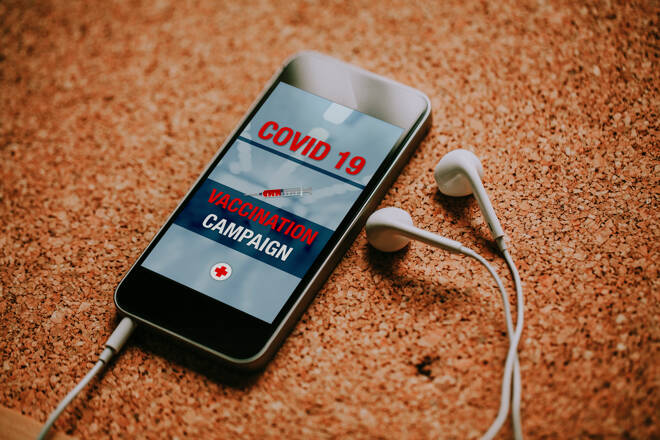Advertisement
Advertisement
COVID-19 Vaccine Update – New Strains and Supply Issues Remain a Concern
By:
While vaccination rates tick up, some of the world's largest economies are continuing to lag. Vaccine shortages will remain a key area of concern.
Vaccine News
Over the weekend, the news wires reported that the Johnson & Johnson vaccine could receive approval in just 2-weeks.
Dr. Anthony Fauci’s comments came amidst announcements of supply issues.
With just 2 vaccines currently approved for emergency use in the U.S, an approval of a 3rd vaccine would ease the strain.
Things may not improve near-term for the likes of the EU, however, which is likely to continue to face supply constraints.
In other parts of the world the AstraZeneca vaccine has already received approval for emergency use. This is not the case in the EU and the U.S, however.
While the EMA is scheduled to review AstraZeneca vaccine later this week, the U.S timeline is far lengthier.
The U.S FDA is currently due to review the AstraZeneca vaccine in April.
It goes without saying, however, that the U.S is not alone in needing access to multiple vaccines.
A Johnson & Johnson and AstraZeneca approval in the U.S and the EU will be key, though supply will remain a concern.
We have heard plenty of bullish production numbers floated by the leading three in the race to end the pandemic.
It remains to be seen, however, if the three can play catch up and meet their 1st quarter targets.
If the most recent updates are anything to go by, the need for a single dose vaccine has become all the more urgent.
Vaccinations Rates
According to the Bloomberg Vaccination Tracker, the U.S has administered 22,396,673 doses as at 24th January.
U.S states have only administered 54% of shots delivered, however, leaving the vaccination rate at just 6.8 doses per 100.
Transportation and storage requirements of both Pfizer Inc. and Moderna Inc.’s vaccines have contributed to the low vaccination rate.
By contrast, the UK has seen its vaccination rate jump to 10.21 doses per 100 people. The UK’s approval of the AstraZeneca vaccine enabled the sharp rise in the vaccination rate.
As at 24th January, Israel continued to have the highest vaccination rate at 39.94.
The UAE ranked 2nd, with a vaccination rate of 23.14, with the Seychelles coming in ahead of the UK, with a rate of 19.12.
In terms of actual doses administered, however, the U.S and China were well ahead of other nations.
As at 20th January, China had administered 15 million doses of the vaccine, sitting behind 22.4 million in the U.S.
In spite of supply issues, the EU ranked 3rd, administering 8.6 million doses.
The UK ranked 4th, with 6.8m doses, followed by Israel (3.6m) and the U.A.E (2.5m)
Looking across the EU, the Netherlands had amongst the lowest vaccination rates. As at 22nd January, the vaccination rate stood at just 0.78 doses per 100 people.
For France, one of the worst affected EU member states, the vaccination rate stood at 1.58. While this was up from 1.49 doses per 100 as at 22nd January, the rise was a marginal one at best.
Germany also trailed the EU front runners, with a rate of 1.96 doses per 100 people as at 23rd January.
Spain and Italy had performed somewhat better, with vaccination rates of 2.51 (22nd January) and 2.28 (24th January) respectively.
For a full breakdown of vaccination rates by country, please visit Bloomberg Vaccination Tracker page here.
The Latest COVID-19 Numbers
At the time of writing, there were a total of 99,774,351 confirmed COVID-19 cases and 2,139,03` related deaths.
By geography, the U.S had reported 25,702,125 cases and 429,490 COVID-19 related deaths.
India reporting 10,668,674 cases, with Brazil reporting 8,844,600 cases.
Sitting behind Russia (3,719,400) remained the UK (3,647,463).
France (3,053,617), Italy (2,466,813), Spain (2,603,472), and Germany (2,147,740) reported a combined 10,271,642 cases.
Looking Ahead
Johnson & Johnson’s vaccine approval by the FDA and AstraZeneca approval by the EMA remain key near-term.
Pfizer Inc. and AstraZeneca, in particular, will also need to address supply issues, however, to support a marked increase in vaccination rates.
Over the weekend, news hit the wires of further lockdown measures to hit France next month.
Of greater concern, however, was reports that vaccinated people can still spread the coronavirus.
For countries with low vaccination rates, this would mean that containment measures may remain in place for longer.
Coupled with the rising number of new and reportedly more virulent strains, border controls could also be seen across a wider number of countries.
For countries with higher vaccination rates, governments will also need to maintain momentum to deliver the 2nd doses.
This will also mean that countries would need to avoid supply constrains to meet the vaccination timelines.
The UK’s British Medical Association Board chair stated last week that there was increased concern that the vaccine would become less effective with doses 12-weeks apart.
It will therefore be all the more important to complete the vaccine dose regimens within optimal timelines.
When considering the supply shortage that the EU currently faces, a quick resolution is going to be needed to avoid making the 8.57 million administered doses redundant.
About the Author
Bob Masonauthor
With over 28 years of experience in the financial industry, Bob has worked with various global rating agencies and multinational banks. Currently he is covering currencies, commodities, alternative asset classes and global equities, focusing mostly on European and Asian markets.
Advertisement
